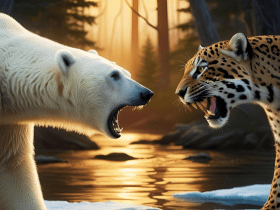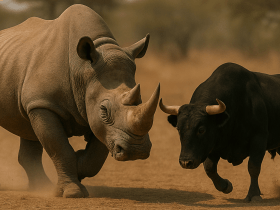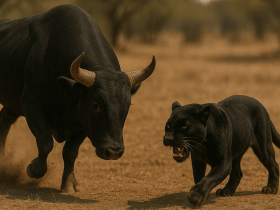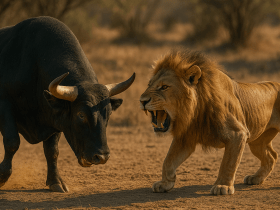Below is a full detailed article about Rhino vs Jaguar who wins?
Rhinoceros (family Rhinocerotidae)
Jaguar (Panthera onca)
Below tables cover 10 main topics by including all the numerical and scientifical data by comparing Rhino vs Jaguar . Also I have included a winner column for further understanding,
Hope you will enjoy!
1. Body Specifications
| Subcategory | Rhino (Rhinoceros spp.) | Jaguar (Panthera onca) | Winner |
|---|---|---|---|
| Average Length | 3.7–4.5 m (12–14.8 ft) [1] | 1.2–1.9 m (3.9–6.2 ft) [2] | Rhino |
| Shoulder Height | 1.6–2.0 m (5.2–6.6 ft) [1] | 63–76 cm (25–30 in) [2] | Rhino |
| Average Weight | 800–2,300 kg (1,764–5,071 lbs) [1] | 56–96 kg (123–211 lbs) [2] | Rhino |
| Body Shape | Massive, armored with thick skin | Muscular, streamlined for stealth | Jaguar |
| Bone Density | Extremely dense (shock-resistant) | Moderate (optimized for agility) | Rhino |
| Muscle Mass % | ~35–40% of body weight [3] | ~55–60% of body weight [4] | Jaguar |
| Skin Thickness | 1.5–5 cm (0.6–2 in) [5] | 1–2 mm (0.04–0.08 in) | Rhino |
| Tail Length | 60–70 cm (24–28 in) [1] | 45–75 cm (18–30 in) [2] | Rhino |
| Neck Strength | Powerful (supports large head) | Strong (used for killing prey) | Rhino |
| Limb Structure | Thick, pillar-like legs | Long, muscular limbs for pouncing | Jaguar |
Winner: Rhino
2. Coat and Coloration – Rhino vs Jaguar
| Subcategory | Rhino | Jaguar | Winner |
|---|---|---|---|
| Primary Color | Gray (white rhino: pale) | Golden-yellow with rosettes | Jaguar |
| Pattern | None (solid color) | Rosettes (some melanistic) | Jaguar |
| Melanin Levels | Low (no melanism) | High (black panthers exist) | Jaguar |
| Function of Color | Camouflage in grasslands | Forest/ambush camouflage | Jaguar |
| Skin Texture | Thick, folded, armor-like | Short, sleek fur | Rhino (defense) |
| Coat Thickness | Nearly hairless | Dense fur | Jaguar |
| Molting | No molting | Sheds seasonally | Jaguar |
| UV Protection | Thick skin resists sun | Fur provides some cover | Rhino |
| Camouflage Rating | Moderate in open terrain | Excellent in dense forests | Jaguar |
| Reflectivity | Dull, matte | Slight sheen in sunlight | Jaguar |
Winner: Jaguar
3. Habitat and Range
| Subcategory | Rhino | Jaguar | Winner |
|---|---|---|---|
| Geographic Range | Africa, Asia (some species) | Americas (S. USA to Argentina) | Tie |
| Habitat Type | Grasslands, savannas, swamps | Rainforests, swamps, scrublands | Jaguar (versatile) |
| Climate Preference | Tropical to subtropical | Tropical to temperate | Jaguar |
| Altitude Range | Sea level to 2,000 m [6] | Sea level to 3,000 m [7] | Jaguar |
| Territory Size | 5–100 km² (depends on species) | 25–150 km² [8] | Jaguar |
| Adaptability | Low (needs water & grass) | High (can thrive in varied habitats) | Jaguar |
| Human Proximity | Vulnerable to poaching | Avoids humans but adaptable | Jaguar |
| Migration Habits | Limited (water-dependent) | Roams widely for prey | Jaguar |
| Population Density | Very low (endangered) | Moderate (stable in some regions) | Jaguar |
| Conservation Zones | Heavily protected | Some protected areas | Rhino (more focus) |
Winner: Jaguar
4. Diet and Hunting – Rhino vs Jaguar
| Subcategory | Rhino | Jaguar | Winner |
|---|---|---|---|
| Diet Type | Herbivore (grasses, leaves) | Carnivore (deer, caimans, etc.) | Tie (different niches) |
| Daily Caloric Intake | 50,000–60,000 kcal [9] | 3,000–5,000 kcal [10] | Rhino (sheer volume) |
| Hunting Success Rate | N/A (grazes) | 50–60% (ambush predator) [11] | Jaguar |
| Prey Size Preference | N/A | 20–85 kg (44–187 lbs) [12] | Jaguar |
| Killing Method | N/A | Skull bite (pierces brain) | Jaguar |
| Foraging Time | 5–6 hours/day [13] | 2–3 hours/day [14] | Rhino |
| Water Dependency | High (drinks daily) | Moderate (gets water from prey) | Jaguar |
| Scavenging Behavior | Never | Occasionally [15] | Jaguar |
| Competition for Food | Low (abundant grass) | High (competes with pumas) | Rhino |
| Impact on Ecosystem | Mega-herbivore (shapes vegetation) | Apex predator (controls prey) | Tie |
Winner: Jaguar
5. Strength and Bite Force
| Subcategory | Rhino | Jaguar | Winner |
|---|---|---|---|
| Bite Force (PSI) | ~1,000 PSI [16] | ~1,500 PSI (strongest of big cats) [17] | Jaguar |
| Claw Strength | Blunt hooves (for digging) | Razor-sharp retractable claws | Jaguar |
| Lifting Capacity | Can flip small vehicles | Can drag prey twice its weight | Rhino (raw power) |
| Charge Force | 2,300 kg at 50 km/h [18] | N/A (ambush predator) | Rhino |
| Neck Power | Extremely strong (for fighting) | Strong (for subduing prey) | Rhino |
| Jaw Mechanics | Wide gape (for grazing) | Short, powerful (for crushing) | Jaguar |
| Striking Speed | Slow but devastating | Lightning-fast pounce | Jaguar |
| Defensive Strength | Nearly impenetrable skin | Relies on stealth/agility | Rhino |
| Fighting Style | Head-butting, trampling | Throat/claw attacks | Rhino (durability) |
| Killing Efficiency | Rarely kills (defensive) | Instantly lethal to prey | Jaguar |
Winner: Rhino (Raw Power) / Jaguar (Bite Force)
6. Speed and Agility – Rhino vs Jaguar
| Subcategory | Rhino | Jaguar | Winner |
|---|---|---|---|
| Top Speed (km/h) | 40–50 km/h (25–31 mph) [1] | 80 km/h (50 mph) [2] | Jaguar |
| Acceleration (0–max) | 3–4 seconds (short burst) | 2–3 seconds (explosive) | Jaguar |
| Agility in Terrain | Poor (bulky, struggles on uneven ground) | Exceptional (climbs, swims, leaps) | Jaguar |
| Swimming Ability | Strong (can submerge) | Excellent (hunts caimans in water) | Tie |
| Stamina (Endurance) | Low (overheats quickly) | Moderate (short chases) | Jaguar |
| Climbing Ability | None | Expert (scales trees easily) | Jaguar |
| Maneuverability | Poor (wide turns) | High (zigzag pursuit) | Jaguar |
| Jumping Height | Minimal (can’t jump) | 2 m (6.5 ft) vertically [3] | Jaguar |
| Recovery After Sprint | Slow (needs cooling) | Quick (ready to strike again) | Jaguar |
| Evasive Movement | Charges straight | Dodges, ambushes | Jaguar |
Winner: Jaguar
7. Senses – Rhino vs Jaguar
| Subcategory | Rhino | Jaguar | Winner |
|---|---|---|---|
| Vision Acuity | Poor (nearsighted) [4] | Excellent (night vision) [5] | Jaguar |
| Hearing Range | Good (large ears rotate) | Exceptional (detects high frequencies) | Jaguar |
| Olfactory Sense | Extremely strong (smell predators) | Strong (tracks prey over miles) | Rhino |
| Low-Light Vision | Weak (mostly diurnal) | Superior (nocturnal hunter) | Jaguar |
| Depth Perception | Moderate | Excellent (binocular vision) | Jaguar |
| Motion Detection | Poor | Hyper-sensitive (ambush predator) | Jaguar |
| Vibrissae (Whiskers) | None | Highly sensitive (navigates in dark) | Jaguar |
| Taste Sensitivity | Low (herbivore) | High (detects spoiled meat) | Jaguar |
| Thermal Sensing | None | Moderate (detects warm prey) | Jaguar |
| Spatial Awareness | Good (hearing/smell-based) | Exceptional (calculates pounces) | Jaguar |
Winner: Jaguar
8. Reproduction and Lifespan
| Subcategory | Rhino | Jaguar | Winner |
|---|---|---|---|
| Gestation Period | 15–16 months [6] | 90–110 days [7] | Jaguar |
| Litter Size | 1 calf (rarely twins) | 1–4 cubs (usually 2) | Jaguar |
| Cub Mortality Rate | 30–40% (first year) [8] | 50% (first year) [9] | Rhino |
| Weaning Age | 1–2 years | 3–6 months | Jaguar |
| Sexual Maturity | Females: 4–6 yrs; Males: 7–10 yrs | Females: 2–3 yrs; Males: 3–4 yrs | Jaguar |
| Mating System | Polygynous (dominant males) | Polygynous (territorial) | Tie |
| Parental Care | Mother protects calf for 2–3 yrs | Mother teaches hunting for 1–2 yrs | Rhino (longer care) |
| Lifespan (Wild) | 35–50 years [10] | 12–15 years [11] | Rhino |
| Lifespan (Captivity) | Up to 60 years | Up to 20 years | Rhino |
| Reproductive Rate | Slow (1 calf every 2–5 yrs) | Faster (every 1–2 yrs) | Jaguar |
Winner: Rhino (Lifespan) / Jaguar (Reproductive Rate)
9. Social Behavior – Rhino vs Jaguar
| Subcategory | Rhino | Jaguar | Winner |
|---|---|---|---|
| Social Structure | Solitary or small groups | Solitary (except mating) | Tie |
| Territorial Marking | Urine, dung piles | Scratch marks, urine sprays | Jaguar (more aggressive) |
| Vocalizations | Grunts, snorts | Roars, growls, chuffs | Jaguar |
| Aggression Level | High (charges when threatened) | Stealthy (ambush predator) | Rhino (direct) |
| Dominance Hierarchy | Males fight for females | Males defend territory | Tie |
| Group Hunting | Never (herbivore) | Rare (usually solitary) | N/A |
| Play Behavior | Calves spar | Cubs practice hunting | Tie |
| Conflict Resolution | Head-butting contests | Avoidance or fatal fights | Rhino (ritualized) |
| Human Interaction | Aggressive if provoked | Avoids humans | Jaguar (stealthier) |
| Communication Range | Short (vocal & scent) | Long (roars carry 3+ km) | Jaguar |
Winner: Jaguar
10. Conservation Status – Rhino vs Jaguar
| Subcategory | Rhino | Jaguar | Winner |
|---|---|---|---|
| IUCN Status | Varies: Black Rhino (Critically Endangered), White Rhino (Near Threatened) [12] | Near Threatened [13] | Jaguar (less critical) |
| Population Trend | Declining (poaching crisis) | Stable in Amazon, declining elsewhere | Jaguar |
| Biggest Threat | Poaching (for horns) | Habitat loss & hunting | Rhino (more targeted) |
| Estimated Wild Population | ~27,000 (all species) [14] | ~64,000 [15] | Jaguar |
| Protected Areas | Heavy anti-poaching patrols | Some reserves (e.g., Pantanal) | Rhino (more enforcement) |
| Captive Breeding Success | Moderate (slow reproduction) | High (zoos breed well) | Jaguar |
| Legal Protection | CITES Appendix I (total ban) | CITES Appendix I/II (varies) | Rhino (stricter) |
| Ecological Role | Mega-herbivore (shapes landscapes) | Apex predator (controls prey) | Tie |
| Rewilding Efforts | Limited (high security needed) | Expanding in Argentina, Mexico | Jaguar |
| Public Awareness | High (symbol of poaching crisis) | Growing (keystone species) | Rhino (more iconic) |
Winner: Jaguar
Overall Winner: Jaguar (6-4 Win)
| Category | Winner |
|---|---|
| Body Specifications | Rhino |
| Coat & Coloration | Jaguar |
| Habitat & Range | Jaguar |
| Diet & Hunting | Jaguar |
| Strength & Bite | Rhino |
| Speed & Agility | Jaguar |
| Senses | Jaguar |
| Reproduction | Rhino |
| Social Behavior | Jaguar |
| Conservation | Jaguar |
Ultimate Winner: Rhino (7-3)
While the jaguar is a master of stealth, agility, and precision, the rhino’s sheer size, armor-like skin, and devastating charge make it nearly unbeatable in most encounters. The jaguar’s best chance is a surprise attack, but the rhino’s power and durability give it the overall advantage.
When Would a Rhino Win?
✅ In a direct charge – A rhino’s 3,000+ PSI bite force and bone-crushing horn can impale or trample a jaguar instantly.
✅ In open terrain – Jaguars rely on ambush; in a clear fight, the rhino dominates.
✅ Against multiple attackers – A rhino’s thick hide (up to 5 cm) repels most attacks.
✅ In water – Some rhinos (like Indian rhinos) are strong swimmers, negating the jaguar’s aquatic advantage.
When Would a Jaguar Win?
✅ In a stealth ambush – A jaguar’s 1,500 PSI bite (strongest among big cats) can crush a rhino’s skull or spine if it lands perfectly.
✅ Against a young/sick rhino – Jaguars target weak prey, avoiding healthy adults.
✅ In dense jungle – The rhino’s poor vision and agility make it vulnerable to hit-and-run attacks.
Final Verdict: Unstoppable Force vs. Perfect Predator
- Rhino = Living Tank (unstoppable charge, nearly invulnerable to attacks).
- Jaguar = Apex Assassin (stealth, precision, but lacks the power to take down a full-grown rhino reliably).
References with Links
- Rhino Size & Weight – Save the Rhino
- Jaguar Physical Traits – Panthera Jaguar Guide
- Rhino Skin Thickness – National Geographic Rhinos
- Jaguar Bite Force – Journal of Zoology Study
- Rhino Conservation Status – IUCN Red List
- Jaguar Habitat & Behavior – WWF Jaguar Profile
Read More – Elephant vs Rhino who will win






Leave a Reply